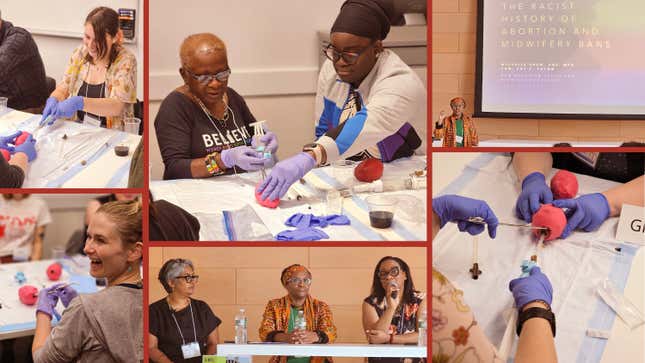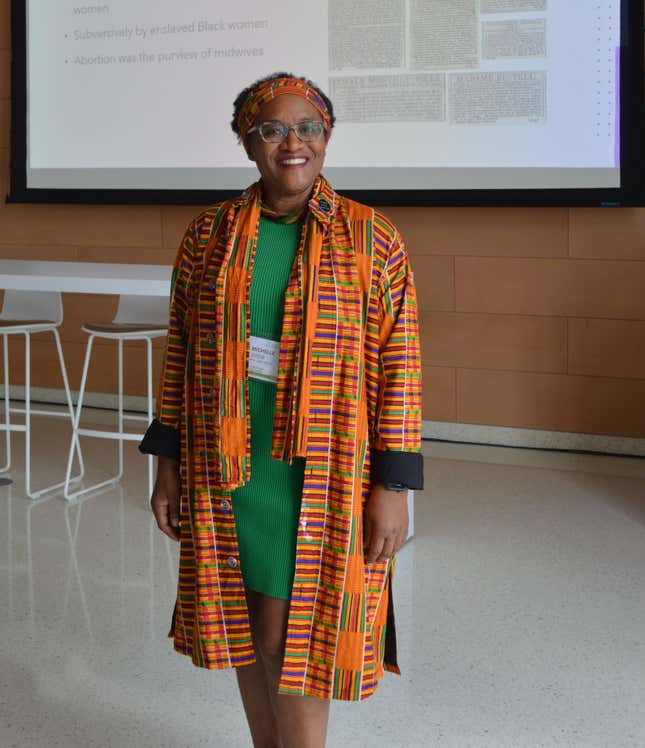Black Midwifery Shows a Way Forward for Abortion Care Despite Brutal Suppression
At a workshop last month, 64 midwives practiced performing abortions on dragonfruit while organizing around midwifery as "an act of resistance."
In DepthIn Depth
Photo: Sofia Rosenberg-Klainberg; Shakera C. Tems
Just after lunch on a Wednesday in June, 64 midwives and midwives-in-training were assembled in a classroom at the Columbia School of Nursing in Manhattan, performing abortions on dragonfruit. Tools were laid out on sterile sheets, just as they would have been if the patient were an actual person and not an exotic fruit. There were forceps to stabilize the “uterus,” a long plastic dilator to open the “cervix,” swabs, “iodine” (soy sauce), lidocaine syringes, and the manual vacuum aspirator, which is used to provide the abortion. The aspirator is made up of a thin plastic cannula that goes into the uterus, and at the other end, a fat plastic syringe, with a plunger that is pulled back to create suction. Seven trainers, both midwives and physicians, watched carefully as the trainee midwives worked in pairs, each taking a turn to hold the fruit steady while the other inserted the long cannula and sucked out the black-speckled pulp.
Michelle Drew, of Ubuntu Black Family Wellness Collective in Wilmington, Delaware, was the workshop’s lead instructor. A certified nurse-midwife with a doctorate in nursing practice, she circled the room to offer feedback on technique, then stopped to help a participant, taking their dragonfruit in one hand and the aspirator in the other. “A lot of times you see people going straight in,” she said, demonstrating how one might insert the cannula into the center of the uterus. “But when you are going in for the first time, go at an angle. So I’m going upward first. Gently, I feel the fundus,” she said, referring to the farthest wall of the uterus. “And then I’m pulling back,” she said, showing how to bring the cannula back towards the cervix. “Now I’m going to change my angle and go downward. Now I’m coming back, and then back in at 9 o’clock, and twisting, twisting. And if you do a good block with the lidocaine, you can relieve the uterine pain as well.” This methodical approach ensures an abortion is thorough, not leaving any pregnancy tissue behind.
Training of this kind is much harder to find than it should be. By New York state law, midwives are able to provide procedural and medication abortion, but they must have extra training for procedural abortion—both classroom instruction and practice, and then clinical training with real patients under the direction of a mentor. But most midwifery schools do not provide that training, partly because it is considered an advanced skill and so is not on the midwifery licensing exam, and partly because there are not enough abortion providers to be clinical mentors. What slots are available are often taken by OB-GYN residents, for whom it is a required part of training. Abortion is not accessible if there aren’t enough providers to train more providers—and that would be true even absent the other factors that make abortion care hard to come by, like restrictive laws, stigma, and suppression. It’s a vicious cycle.
“I have an obligation to serve your interests and your family’s interests, before I necessarily stick to rules that don’t make sense and that were actually intended to harm you.”
Here is what happens when there are not enough abortion providers: Drew told me the story of a woman named Precious. (“And she was. She was a wonderful young mother, just beautiful and sweet,” Drew said.) Precious acquired a heart condition during one of her pregnancies; she lost two-thirds of her heart function and was advised that she shouldn’t get pregnant again. But she did, and at first she felt fine. But by 14 weeks, it was clear that her heart was not going to make it through this pregnancy, and she needed to terminate. Drew, who at the time could not legally perform abortions, tried and tried to get her an appointment with a physician who could. But the few physicians who could do second trimester abortions were fully booked, partly because they were also providing so many low-risk first term abortions—exactly the kinds of abortions midwives could have safely performed. Drew called and called and Precious waited and waited, her heart function deteriorating. There were no appointments available before Precious crossed the 22 weeks and six days mark, after which Delaware prohibits abortion. She was not yet sick enough to qualify for an exception—at least not until 28 weeks, and by that time, the question became when to deliver instead of when to have an abortion. In the end, Precious gave birth to her baby at 32 weeks and then she died of heart failure. Drew went to her funeral.
“If you had advanced practice nurses [like midwives] and physician assistants who should have been available to do first trimester abortions in the office, then those physicians would’ve been available,” Drew said. “Women have died just because they couldn’t get an abortion before the state cut off, because there just weren’t enough abortion providers.”
Nineteen states and the District of Columbia allow some or all advanced practice clinicians—like midwives, nurse practitioners, and physician assistants—to provide procedural abortions. These clinicians generally do first trimester procedures, which account for more than 90 percent of abortions—and research has shown that first trimester abortions provided by those clinicians are just as safe as those provided by physicians. But none of that matters if midwives can’t get the training they need, and then can’t get the hospitals and clinics in which they work to let them provide care—because some administrators don’t even realize midwives can provide abortions or because the physicians who perform abortions don’t want midwives to join them. Both midwifery practice and abortion care have been suppressed, historically and more recently, by groups like the American Medical Association. (The AMA’s position is that abortion is both a human right and medical care. But whereas the AMA opposes the independent practice of medicine by non-physicians, other professional organizations do support qualified non-physicians providing abortion care, including the American College of Obstetricians and Gynecologists.) In fact, many people in the general public don’t realize how much midwives and other non-physician providers can do.
And that is where this conference, held by New York Midwives, came in: According to the organizers, it was the largest abortion training for midwives ever held. One goal was certainly to train these midwives, who came from New York, New Jersey, and Connecticut, to individually provide abortions. But there was also a systemic goal, to organize midwives to break down the many barriers to abortion care.

Drew was involved in changing the law in Delaware in 2022, which made it legal for advanced practice clinicians to perform abortions. She sees full spectrum sexual and reproductive care as part of her responsibility, as her grandmother and great-grandmother were both midwives who provided all the care their communities needed. She pointed out that, although abortion was legal in the United States until the mid-1800s, enslaved Black women were always prohibited from controlling their own fertility—nevertheless, enslaved midwives did provide abortion and contraception, even when they had to do it surreptitiously. “For Black midwives, this has always been a necessity and an act of resistance,” she said. “As a Black midwife, I had an obligation to continue to be part of that resistance to make sure that Black women had access to abortion the same way that my grandmother did, the same way that my great-grandmother did. And the way so many Black midwives did, at the risk of their own personal safety for 400 years.” In other words, Black midwives have always operated within brutal suppression—and Black midwifery knows ways of moving forward despite suppression. Drew grounded the workshop in that perspective, specific to Black American midwifery.
-

-

-

-

-

-

-

-

-

-

-

-

-

-

-

-

-

-

-

-

-

-

-

-

-

-

-

-

-

-

-

-

-

-

-

-

-

-

-

-








































